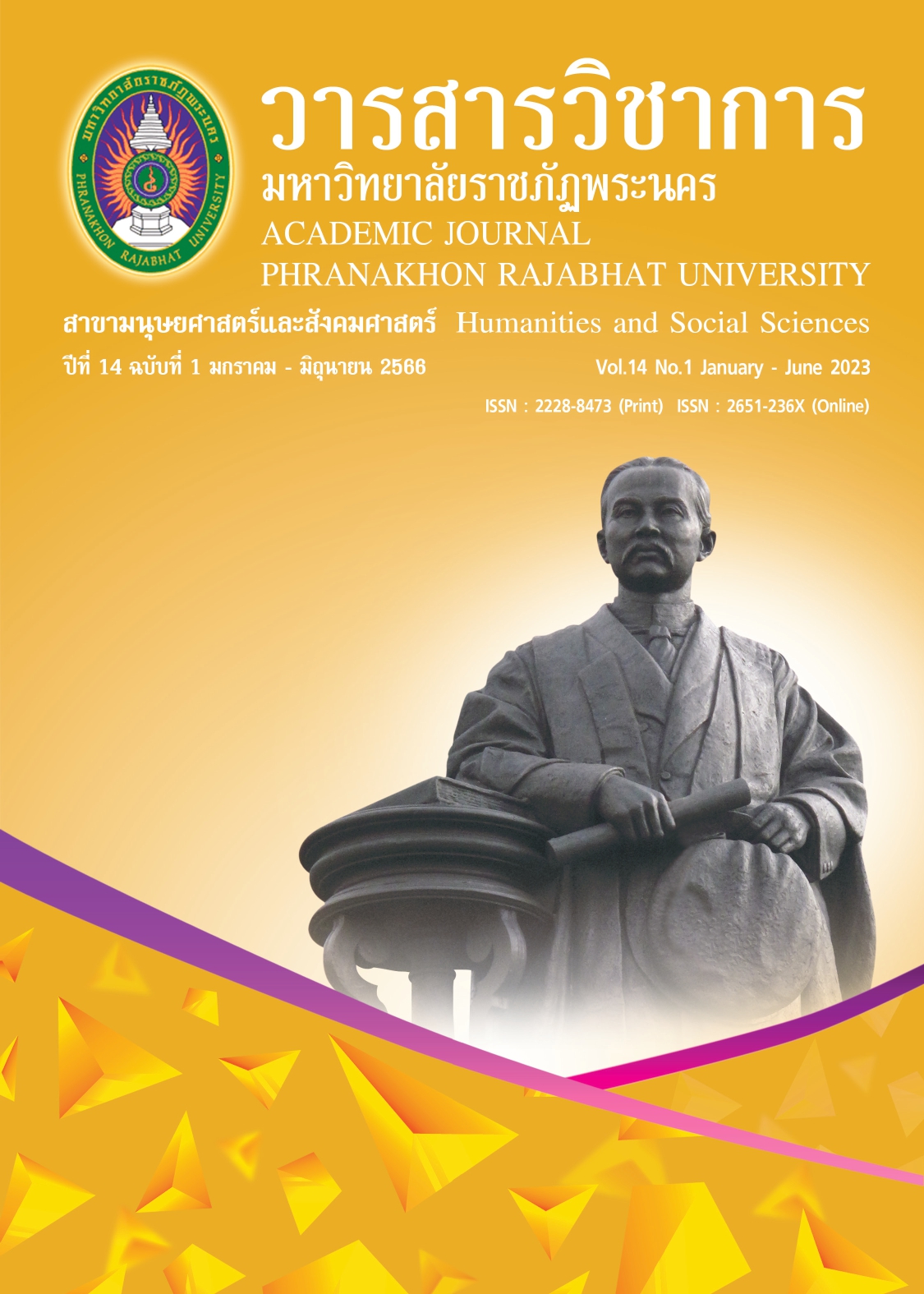FAKE NEWS CATEGORIES FOUND IN LINE GROUP OF ELDERLY LIVING IN NONTHABURI MUNICIPALITY
Keywords:
Fake news, Elderly, Social Media, Line ApplicationAbstract
This research focused on describing characteristics of fake news appearing on instant messaging application and elements of fake news on social media influencing the perception and fake news transmission among the elderly living in Nonthaburi Municipality via LINE application. The aims were to obtain information that would improve knowledge and understanding of digital media literacy among the elderly and increase their ability to use social media. By doing so, this research applied both qualitative and quantitative methods that suited each data type in answering the research questions. The study was found that: 1) fake news with improper content was found the most. The result showed its intention; that was to freshly invent the fake news to attract people. The invention included images, headlines, content, and information appearing in the news. 2) Elderly living in Nonthaburi municipality consumed news and information according to their personal interest such as daily news information, health issue and religion values. They admitted forwarding news and information via LINE application instead of social conversation, and 3) important factors in persuading elderly of their forwarding fake news on LINE application were the quality and reliability of the news including their own perception on the issue including their bias and personal judgement of the issue too.
References
Adornato, A. & Lysak, S. (2017). You Can’t Post That!: Social Media Policies in U.S. Television Newsrooms. Electronic News, 11(2), 80-99.
Adornato, A. (2016). Forces at the Gate: Social Medias Influence on Editorial and Production Decisions in Local Television Newsrooms. Electronic News, 10(2), 87-104.
Allcott, H. & Gentzkow, M. (2017). Social media and fake news in the 2016 election. Journal of Economic Perspectives, 31(2), 211–236.
Bangkok Post. (2019). Anti-fake news centre pins blame on elderly. Retrieved from https://www.bangkokpost.com/thailand/general/1806984/anti-fake-news-centre-pins-blame-on-elderly. [2019, 29 Dec.]
Bessi, A., Zollo, F., Del V.M, Puliga M., Scala, A., & Caldarelli G. (2016). Users Polarization on Facebook and Youtube. PLoS ONE, 118). doi: 10.1371/journal.pone.0159641. PMID: 27551783; PMCID: PMC4994967.
Boonprasert, C. (2017). Factors Influencing the Adoption of Line Application Using for Elderly Users. (Master desertion). Chiang Mai Rajabhat University, Chiang Mai. (In Thai)
Boyd, d.m. & Ellison, N.B. (2007). Social Network Sites: Definition, History, and Scholarship. Journal of Computer Mediated Communication, 13(1). 210–230.
Burkhardt, J. (2017). Library Technology Reports: Combating Fake News in the Digital Age. Chicago, USA: American Library Association.
Chayrattrakul, V. (2020). Anti-Fake News Center. Hundreds of Stories Mueang Thai. Parliamentary Broadcasting Station. Retrieved from https://dl.parliament.go.th/backoffice/viewer2300/web/viewer.php. [2019, 20 Dec.]
Department of Older Persons. (2019). Measures to drive the national agenda on the aging society (Revised). Bangkok, Thailand: Amarin Printing and Publishing Public Company Limited. (In Thai)
Electronic Transactions Development Agency. (2019). Thailand Internet User Behavior (2019). Bangkok: ETDA Publications.
Erickson, L.B. (2011). Social media, social capital, and seniors: the impact of Facebook on bonding and bridging social capital of individuals over 65. In AMCIS 2011 Proceedings - All Submissions. 85. Retrieved from https://aisel.aisnet.org/amcis2011_submissions/85. [2019, 20 Dec.]
Economic and Social Commission for Asia and the Pacific (2019). Economic and Social Survey of Asia and the Pacific 2019: Ambitions beyond growth. Bangkok: United Nations publication.
Finn, K. (2010). Social media use by Older Adults. Retrieved from http://wiserusability.com/wpfs/wpcontent/uploads/2015/07/Social-Media Use-by-Older-Adults.pdf. [2019, 14 Dec.]
Gu, L., Kropotov, V., Yarochkin, F., Leopando, J., & Estialbo, J. (2017). Fake news and cyber propaganda: The use and abuse of social media. Trend Micro, Retrieved from https://www.trendmicro.com/vinfo/us/security/news/cybercrime-and-digitalthreats/fake-news-cyber-propaganda-the-abuse-of-social-media. [2019, 12 Dec.]
Guess, A., Nagler, J. & Tucker, J. (2019). Less than you think: Prevalence and predictors of fake news dissemination on Facebook. Science Advances, 5(1). DOI: 10.1126/sciadv.aau4586.
Haile, T. (2014). What You Think You Know about the Web Is Wrong. Time.com. Retrieved from http://time.com/12933/what-you-think-you-know-about-the-web-is-wrong/ [2019, 21 Dec.]
Hampton, K. (2016). Persistent and pervasive community: New communication technologies and the future of community. American Behavioural Scientist, 60, 101–124. doi:10.1177/0002764215601714
Komson, K. (2018). Let's see the results of marketing research from CMMU on which media to market with to be popular with elderly. Retrieved from https://www.marketingoops.com/reports/behaviors/silver-age-marketing-cmmu/khunkomsan, 2018). [2019, 21 Dec.]. (In Thai)
Lewis, S. & Ariyachandra, T. (2010). Seniors and Online Social Network Use. Conference on Information Systems Applied Research. 2010 CONISAR Proceedings. 3,(1552). 1-15. Retrieved from http://proc.conisar.org/2010/pdf/1522.pdf. [2019, 23 Dec.]
Mena, P. (2017). Why People Share Fake News. Retrieved from https://www.jou.ufl.edu/insights/people-share-fake-news/. [2019, 21 Dec.]
Miller, D. (2011). Tales from Facebook. Cambridge: Polity.
Ministry of Social Development and Human Security (2003). The Elderly Act B.E. 2546, Bangkok: Ministry of Social Development and Human Security Publications. (In Thai)
National Statistical Office. (2017). Nonthaburi Provincial Statistical Report. Nonthaburi: Nonthaburi Provincial Statistical Office. (In Thai)
Ohanian, R. (1990). Construction and Validation of a Scale to Measure Celebrity Endorsers' Perceived Expertise, Trustworthiness, and Attractiveness. Journal of Advertising, 19(3), 39-52.
Smith, A. (2014). Older Adults and Technology Use. Pew Research Center, Internet Science & Technology. Retrieved from http://www.pewinternet.org/2014/04/03/older-adults-and technology-use/ [2019, 12 Dec.]
The European Association for Viewers Interests. (2016). Infographic: Beyond Fake News. Retrieved from https://eavi.eu/beyond-fake-news-10-types-misleading-info/[2019, 20 Dec.]
Wardle, C. (2017). Fake news. It’s complicated. Retrieved from https://firstdraftnews.org/latest/fake-news-complicated/ [2019, 20 Dec.]
Wikipedia. (2015). Social Media. Retrieved from https://en.wikipedia.org/wiki/Social_media [2019, 21 Dec.]
Wikipedia. (2016). Line Software. Retrieved from https://en.wikipedia.org/wiki/Line_(software) [2019, 21 Dec.]
Wongpanarak, N., & Chaleoykitti, S. (2015). Depression: A Signifiant Mental Health Problem of Elderly, Royal Thai Army Nurses. 15(3). 24-31. (In Thai)
Downloads
Published
How to Cite
Issue
Section
License
Copyright (c) 2023 Academic Journal Phranakhon Rajabhat University

This work is licensed under a Creative Commons Attribution-NonCommercial-NoDerivatives 4.0 International License.
"บทความวิชาการในวารสารฉบับนี้ ถือเป็นความรับผิดชอบของผู้เขียนเท่านั้น"
สงวนลิขสิทธิ์ตามพระราชบัญญัติลิขสิทธิ์




